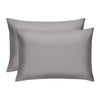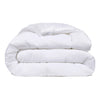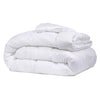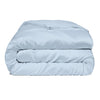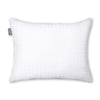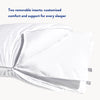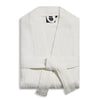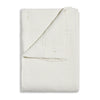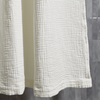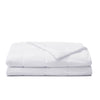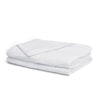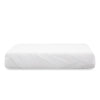
Glue stains are some of the most difficult stains to tackle, especially when they land on your favorite clothes. These sticky situations can seem daunting, whether it’s a drop of super glue from a quick repair or a smear of hot glue during a craft project.
This guide will arm you with the tools and techniques to effectively remove glue from fabric, restoring your garments to their former glory. From household items to simple steps, you'll learn how to approach even the most stubborn adhesive residues with confidence.
Why Are Glue Stains So Tricky?
Glue comes in many forms, each with its own set of challenges, but fundamentally, the answer is in the question. Glue is designed to stick things together — so pulling glue off of something it has adhered to without causing damage can be a real challenge by default.
Hot glue is often used in DIY projects and can drip onto fabric, quickly hardening upon cooling. Nail glue, used for applying artificial nails, can also create stubborn bonds with fibers when accidentally dropped or smeared on clothing. These different types of adhesives require specific approaches for removal.
Knowing how to identify the type of glue is the first step in effective glue stain management. Each adhesive has a unique solvent that can dissolve it without damaging the fabric, from water-based glues that loosen with a soak to super glue stains that often need a targeted approach, like acetone or nail polish remover.
Tips for Removing Glue Stains
Acting quickly can prevent the glue from setting permanently. If you notice that you’ve ended up with glue dripping onto your favorite shirt, don’t panic. Start with these two simple steps to prepare your garment for an effective de-gluing process.
1. Scrape Off Excess Glue
Use a dull knife or a butter knife to gently lift away any dried glue without spreading it further. If the glue is still tacky, a piece of ice can be used to harden it, making it easier to scrape off without embedding it deeper into the fabric.
For smaller or more delicate areas, a cotton swab or toothbrush can help remove any remaining glue without harming the texture of the fabric.
2. Check the Care Label
Always consult the garment's care label before attempting any form of stain removal. This ensures the fabric, especially delicate fabrics like acetate, won’t suffer further damage. If the label suggests dry cleaning, consider taking the garment to a professional instead of attempting to remove the glue yourself.
For washable fabrics, testing a small, inconspicuous area with your chosen solvent — be it rubbing alcohol, white vinegar, or another appropriate cleaner — can prevent discoloration or further damage to the garment.
Step-by-Step Guide To Removing Glue Stains
For Water-Based Glues
Begin by thoroughly rinsing the stained area with cold water to remove as much glue as possible. Cold water helps to stop the glue from setting further into the fabric.
Next, you can apply your chosen stain remover or a trusted laundry detergent. Gently dab the affected area with a cotton swab or clean cloth. Allow the solution to penetrate the glue for a few minutes to break down the adhesive properties.
After letting it rest, load the garment into the washing machine and add an appropriate amount of laundry detergent. Select a wash cycle that matches the care label instructions to ensure the fabric is treated gently. After washing, let the garment air dry to ensure any remaining glue is completely removed.
For Super Glue and Nail Glue
Sometimes, DIY solutions are the most effective. Carefully apply a small amount of acetone or nail polish remover to a cotton ball.
Before tackling the glue stain, test this solvent on an inconspicuous area of the fabric to ensure there is no discoloration or damage. Gently dab the solvent onto the glue stain, allowing it to break down the adhesive.
Once the glue residue begins to loosen, rinse the stained area with warm water. If traces of glue persist, repeat the steps with acetone and a fresh cotton ball until the glue is completely removed. It’s important to handle the fabric gently to avoid spreading the glue or causing further damage.
For Hot Glue
This may come as a surprise, but the answer to your problems might be as simple as ice cubes. Press ice cubes against the glue stain until the hot glue hardens significantly. This method makes it easier to scrape off the solidified glue using a dull knife or a butter knife without pulling the fabric.
If some glue remains, place a clean cloth over the affected area and carefully iron over it on a low heat setting. The heat will soften the remaining hot glue, making it easier to wipe away with a paper towel or clean cloth. Check the care label to ensure the fabric can handle the heat.
What Next?
Once the glue is out, maintaining the pristine condition of your garments is next. Rather than tossing your garment in the dryer, always let the garment air dry after treating a glue stain to ensure no hidden residues set in with heat.
This is particularly important when you've used solutions like rubbing alcohol or acetone on delicate fabrics, as high heat from a dryer can cause the residues of these chemicals to affect the fabric's integrity.
It’s wise to keep tools like a toothbrush or cotton swab handy in your laundry area for treating small or hard-to-reach areas of a garment. Gentle brushing can help work the detergent into the fibers without spreading the stain. Follow these steps consistently, and you’ll find that keeping your clothing in top condition is easier than you might think.
Which Detergent Should You Use?
Choosing the right detergent for tough stains can be tricky, but there’s only one right answer: our Miracle Made® Laundry Detergent Sheets. These sheets pack a powerful punch against stains while being gentle on the environment and your skin. The innovative formula includes natural ingredients like coconut oil extract, ensuring effective glue removal without harsh chemicals.
Our detergent sheets stand out not just for their stain-fighting capabilities but also for their eco-friendly attributes. They contain no harsh solvents or bleach, making them safe for handling super glue stains on delicate fabrics without risk of discoloration or further damage. The sheets are pre-measured, ensuring you use just the right amount each time, eliminating waste and excess.
Their ultra-concentrated design means you use less product per wash, reducing waste and keeping your laundry area clutter-free. The sheets dissolve effortlessly in cold or hot water and are suitable for all washing machine types, even HE machines.
This versatility makes them an excellent choice for households that value efficiency and sustainability. Plus, the convenience of these sheets allows for easy handling and storage, unlike traditional bulky liquid detergents and powders.

The Final Sticking Point
Successfully removing glue stains from your clothes can feel like a major victory. With the right approach, what might seem like a permanent mess can often be resolved with a few thoughtful strategies.
The key to conquering these sticky adversaries lies in prompt and proper treatment. By following the outlined methods, you can preserve the quality and appearance of your fabrics, ensuring that accidental spills don't lead to lasting damage.
Now that you know how to tackle these tough stains, your wardrobe will stay looking sharp and spotless.
Sources:
Your Complete Guide to Understanding Care Labels | Planet Care


